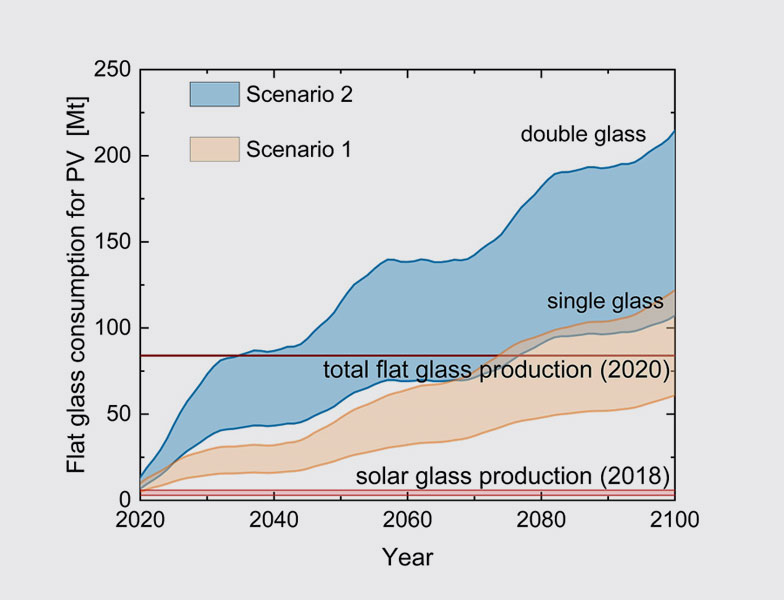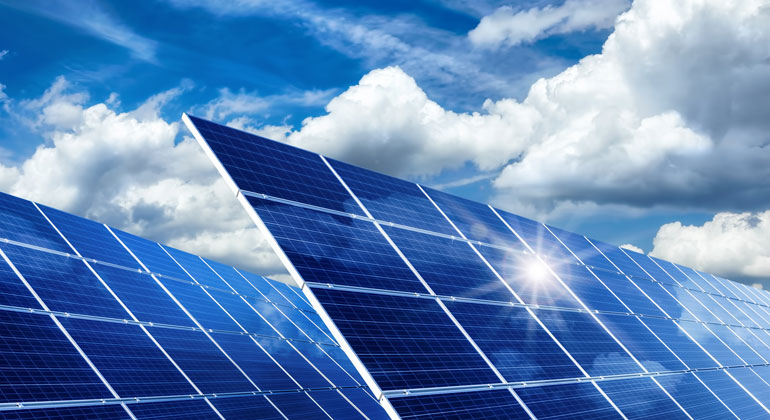Study: Technological Learning is Key for Resource Efficient Terawatt Scale Photovoltaics
Cost efficient climate change mitigation requires installing a total of 20-80 TWp photovoltaics until 2050 and 80-170 TWp until 2100, at least a hundred times more than the 707 GWp standing at the end of 2020. A research team from the Fraunhofer Institute for Solar Energy Systems ISE and the Potsdam Institute for Climate Impact Research has now analyzed whether the projected growth is feasible from a resource point of view- and if so, under which conditions, in the paper »Technological learning for resource efficient terawatt scale photovoltaics« (Energy & Environmental Science, September 2021). The currently high rate of innovation must be upheld to avoid resource constraints, they find.

Although photovoltaics (PV) has been identified as the most important renewable energy technology for cost optimized climate change mitigation, the associated massive demand for resources is rarely discussed. In its study, the research team estimated the resource demand for PV systems along a path towards a terawatt-scale PV industry, which is necessary for limiting global warming to 1.5°C. They focus on the main resources needed independently from the specific nature of the used technology, which are energy, float-glass, capital investments and as an exemplary metal, silver.
Technological Learning Keeps Resource Demand within Reasonable Limits
The analysis shows that without continued technological learning, resource limitations will most likely hinder terawatt-scale PV deployment. “Luckily, the photovoltaic technology is constantly evolving, and new generations of systems are more efficient and consume less resources during production,” explains Dr. Jan Christoph Goldschmidt, Head of Group Novel Solar Cell Concepts and the first author of the paper, “We must maintain this development also in the long-term future.” Already now, technological solutions like perovskite-based tandem solar cells are being developed in laboratories that promise high efficiencies at low-costs and low resource consumption.
“Limiting global warming to 1.5° C at lowest costs requires a 7-to 14fold increase of PV capacity until 2030 and a continued scaleup afterwards,” explains Robert Pietzcker from the Potsdam Institute for Climate Impact Research.“ Building the global PV infrastructure will consume several percent of the remaining greenhouse gas emission budget compatible with the 1.5°C goal, the authors have estimated under the assumption of technological learning, but then PV will deliver more than half of the global electricity demand. “Because the remaining carbon budget is so small, it is crucial to make also PV as efficient as possible as fast as possible,” stresses Lukas Wagner from Fraunhofer ISE. In the long run, only 4-11% of electricity produced from PV will be needed to produce PV systems, both for replacements and continued capacity expansion, the study finds. This “own-consumption” is comparable with that of current fossil energy technologies, just as projected yearly investments will be in the same order of magnitude as the revenues of the largest oil and gas companies.
The massive expansion of PV production will also increase glass demand, but the continued increase in module efficiency reduces the module area per Wp and thus directly the amount of glass needed. The team estimates an annually produced module area of 12,000-22,000 km2 by 2100, which is in the order of the entire current global float-glass production. From a resource perspective, this is probably not critical since sand reserves are abundant and glass is recyclable, but as the current float-glass production capacity is today already fully absorbed by other markets, solar glass production capacities need to be expanded rapidly.
As for silver, there is a strong historic trend to reduce the amount of silver due to high prices and improvements in printing technologies. If this development continues, the total silver consumption will remain below 18,000 t or, in the best case, could stay roughly at today’s level. Indium that is used for transparent conductive oxides in multi- junction cells is another element that could become critical.
“The results of our study present us with some urgent tasks,” Goldschmidt emphasizes. “Developing low emission PV technologies should become a priority. A rapid expansion in float glass production capacity within the next 10 years is necessary and we will also need recycling facilities that can cope with the enormous material flows. We also need to transfer multi-junction technologies to the industry to achieve the necessary high efficiencies, and the replacement of indium in transparent conductive layers is still a challenge.” The authors conclude that current and future investments must therefore not only be targeted at capacity expansion but also at upholding the currently high rate of innovation with a focus on sustainability.








